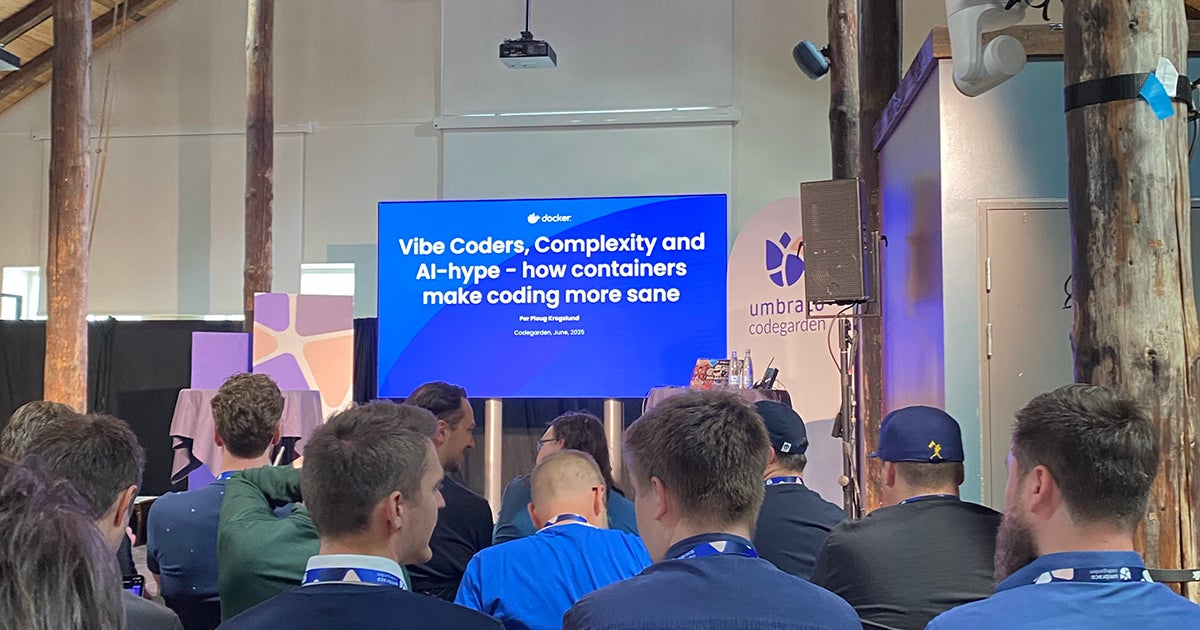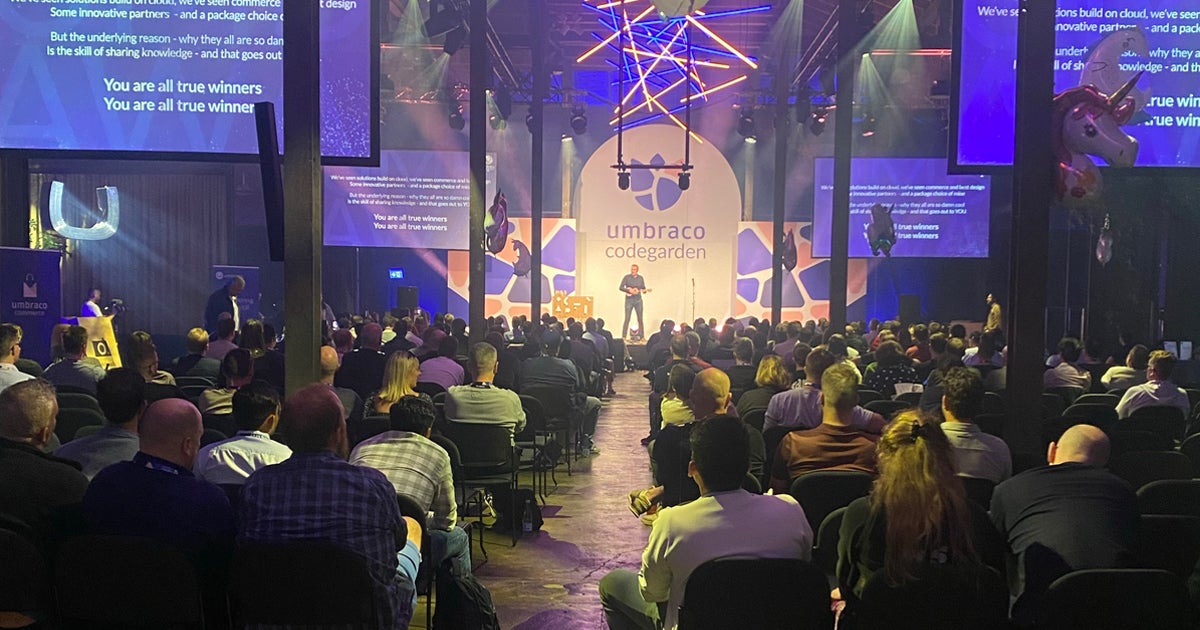Umbraco's CodeGarden 2025: Highlights, Learnings, and What’s Next
What an incredible week celebrating the 20th anniversary of CodeGarden — the world’s largest Umbraco conference! After three days of inspiring and thought-provoking sessions in Odense, Denmark, I'm experiencing the same "CodeGarden blues" as in 2024.
This special edition of the conference offered valuable insights into Umbraco's future direction and showcased cutting-edge technologies that will shape how the developer community builds and delivers digital experiences. Now that we’re back from Denmark, it’s the perfect time to reflect on the key takeaways from this milestone gathering.

Keynote Highlights: The Future of Umbraco
The opening keynote delivered exciting announcements across the entire Umbraco ecosystem, setting the stage for what promises to be a transformative year ahead.
Core CMS Innovations
The keynote provided an excellent reflection on recent innovations that have transformed the Umbraco experience. Features like Block Level Variations, Lazy Loaded Content Cache, and the TinyMCE to TipTap migration have already proven their value in real-world implementations, showcasing Umbraco's commitment to continuous improvement in editor experience and performance optimisation.
Looking ahead, two major new features are set to further revolutionise how we build and manage content:
Reusable content functionality will streamline content management workflows, allowing content creators to build once and deploy across multiple contexts. This will be particularly valuable for large-scale sites where content consistency and efficiency are paramount.
Enhanced search capabilities represent the future of Umbraco search, with Kenn Jacobsen's dedicated session revealing the exciting scope of these developments. The new search system features:
- A new abstraction layer between Umbraco and your chosen search provider for greater flexibility
- Allow mix and match of search providers allowing developers to choose the best solution for each use case
- Advanced search features including filters, faceted search, and by-field querying
- Flexible indexing strategies with customisable content indexes and property value handlers
This comprehensive search overhaul will initially be available as an add-on for V16/17 before being integrated into the core in V17, giving developers unprecedented flexibility in how they implement search functionality across different project requirements.
Cloud and Hosting Evolution
Umbraco Cloud continues to evolve with several exciting developments:
- Flexible environment management allowing teams to spin up dedicated development and testing environments
- Improved cloud bandwidth with more flexible traffic management
- Hostname monitoring for better site management
- Active Directory integration for enterprise authentication needs
- Dedicated database support (coming soon) for enhanced performance
- Load balancing capabilities to handle high-traffic scenarios
Introducing Umbraco Compose: Enterprise-Grade Integration
One of the most exciting announcements was Umbraco Compose — a rival to existing services like Enterspeed, a new enterprise product designed to bridge the gap between Umbraco and third-party systems. This solution enables:
- Seamless content ingestion from multiple external sources
- Using GraphQL for modern, flexible content delivery
- Webhook integration to push content updates to external services
- Synchronised third-party systems ensuring data consistency across platforms
- Direct integration back into the Umbraco CMS to view content from Engage directly in the CMS
For 26-DX, Umbraco Compose opens new possibilities for complex enterprise integrations that previously required significant custom development.
AI Integration: The Game Changing Official Umbraco MCP Server
The announcement of Umbraco's official Model Context Protocol (MCP) server represents a major leap forward in AI integration. As demonstrated in Phil Whittaker and Matthew Wise's session "From Clicks to Commands: AI for Editors, Developers, and Everyone Else", this technology enables AI agents to interact directly with Umbraco's Management API.
The MCP server allows AI to chain tasks together intelligently, automating complex workflows that would typically require tedious manual work in the UI. From bulk content creation to sophisticated content updates, the possibilities are truly endless. The example showing an integration with Claude requires no deep AI expertise, making it accessible for developers at all levels.
The Future of Web Interaction: the Browser-Based AI Revolution
Önder Ceylan's presentation "Future of Web AI: Integrating On-Device Models and LLMs in the Browser" opened our eyes to a privacy-first, offline-capable future. Key takeaways include:
- Client-side AI processing eliminating cloud dependencies
- Enhanced privacy protection with on-device model execution
- Offline functionality for AI-powered features
- Reduced latency through local processing
- Cost savings by minimising cloud AI service usage
Technologies like TensorFlow.js, Transformers.js, MediaPipe, and WebLLM are making sophisticated AI capabilities available directly in browsers, with frameworks supporting everything from sentiment analysis to real-time image processing.
Rethinking Web Architecture
Rutger Stoel's thought-provoking talk "The Web in 2028: Do We Even Need Websites in the Future?" challenged our fundamental assumptions about web interfaces. Key insights include:
- Designing for intent rather than interfaces, focusing on context and real user needs
- From interfaces to intelligences — where AI agents learn users rather than requiring users to learn systems
- Agent-first design, where our next users might be AI acting on behalf of humans
- The evolution of UX towards Agent Experience Designers, who create seamless AI interactions
While websites won't disappear, they'll evolve to become more useful and less focused on traditional navigation patterns. This requires us to build with clear APIs, machine-readable content, and semantic data structures.
Looking at Advanced Development Approaches

Container Adoption
Per Krogslund's from Docker session "Vibe Coders, Complexity, and AI-hype – How Containers Make Coding Sane" made a compelling case for Docker adoption across the entire software development lifecycle. Key benefits include:
- Test containers for spinning up throwaway containers with actual dependencies
- Creating consistent development environments across team members
- Simplified deployment processes from development through to production
- AI container integration enabling sophisticated testing scenarios
- Semantic testing capabilities for search and content validation
Bridging Design and Development
Peter Gregory's talk on "Bridging the Gap: Design to Development" highlighted the persistent challenges between design teams and developers. The integration of visual design tools like Plasmic with headless Umbraco creates new opportunities for cross-functional collaboration, allowing designers to work more closely with content structures while maintaining developer control over implementation.
Looking Forward: Key Implications
These developments at CodeGarden 2025 present several exciting opportunities:
- AI-First Development – The MCP server integration will allow developers to offer clients AI-powered content management solutions that dramatically reduce manual work
- Enhanced Enterprise Offerings – Umbraco Compose opens new possibilities for complex system integrations
- Performance Optimisation – Browser-based AI and improved caching mechanisms will help deliver faster, more responsive sites
- Search Innovation – The new search capabilities will enable more sophisticated content discovery experiences and easily integrate search providers with Umbraco.
Wrapping Up CodeGarden 2025

CodeGarden 2025's 20th anniversary celebration was a perfect blend of technical innovation, community connection, and forward-thinking presentations.
The future of Umbraco has never looked brighter, with AI integration, enhanced cloud capabilities, and developer-friendly innovations positioning it as a truly modern CMS platform. These advancements will undoubtedly shape how we — at 26-DX and across the wider Umbraco community — approach future projects, enabling the delivery of more sophisticated, efficient, and forward-thinking digital solutions.
Thank you to the entire Umbraco team — here's to the next 20 years of innovation! #h5yr
Our insights
Tap into our latest thinking to discover the newest trends, innovations, and opinions direct from our team.